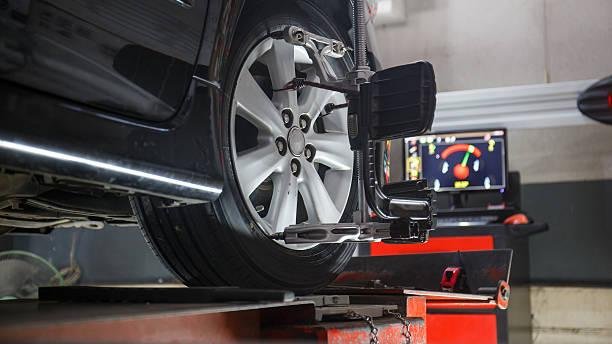Wheel alignment is essential for maintaining vehicle stability, tire health, and overall driving safety. Properly aligned wheels ensure that your tires make even contact with the road, providing smoother rides, better fuel efficiency, and reducing unnecessary wear and tear. Misaligned wheels, on the other hand, can lead to uneven tire wear, steering issues, and even pose risks during emergency maneuvers.
While professional alignment checks are recommended periodically, it’s possible to conduct a basic check of your wheel alignment at home. This can help you detect potential issues early, saving you time and money by addressing alignment problems before they escalate. In this article, we’ll walk you through the steps to check your wheel alignment at home.
1. Understanding Wheel Alignment
Before diving into the process, it’s important to understand what wheel alignment is and what it affects. Wheel alignment refers to the adjustment of a vehicle’s suspension, not the wheels themselves. Specifically, alignment ensures that your vehicle’s tires meet the road at the proper angle, with all tires pointing in the same direction.
There are three key aspects of wheel alignment:
- Camber: The inward or outward tilt of the tire when viewed from the front of the vehicle. If the top of the tire leans outward, it’s called positive camber; if it leans inward, it’s negative camber. Improper camber can cause uneven tire wear.
- Toe: The angle at which the tires point inward or outward when viewed from above. “Toe-in” means the front of the tires point towards each other, while “toe-out” means they point away from each other. Incorrect toe can lead to excessive tire wear and affect handling.
- Caster: The angle of the steering pivot when viewed from the side of the vehicle. Positive caster helps with stability, while negative caster can make steering difficult.
2. Signs of Misalignment
Before conducting an alignment check at home, consider whether you’re experiencing any symptoms of misaligned wheels. Here are common signs:
- Uneven tire wear: If one side of the tire is more worn than the other, it’s a sign that the wheel alignment is off.
- Pulling to one side: When driving straight, your vehicle should not drift to the left or right. If it does, this indicates misalignment.
- Steering wheel is off-center: If your steering wheel isn’t centered while driving straight, your wheels may be misaligned.
- Vibrations or wobbling: A vibrating steering wheel at high speeds or an unstable ride is often linked to alignment problems.
If you notice any of these symptoms, it’s a good idea to check your alignment before scheduling a professional inspection.
3. Tools You’ll Need
Before you begin the alignment check, gather the following tools:
- Tape measure
- A piece of string or straight-edge (a long piece of wood or metal)
- Level (optional but helpful)
- Chalk or painter’s tape (to mark tire positions)
- Jack and jack stands (to lift the car if needed)
These simple items will help you conduct a basic alignment check at home without the need for professional-grade equipment.
4. Check Tire Pressure First
Before checking the alignment, it’s important to ensure your tires are properly inflated. Misaligned tires can cause uneven pressure distribution, but underinflated or overinflated tires can also give false alignment symptoms. Use a tire pressure gauge to make sure all tires are inflated to the manufacturer’s recommended PSI (pounds per square inch), which can typically be found on the driver’s side doorjamb or in the vehicle manual.
5. How to Check for Toe Alignment
Toe alignment is one of the easiest aspects to check at home, and it can be done using a simple measuring method. Follow these steps:
- Park on a flat surface: Make sure your vehicle is on level ground and the wheels are straight.
- Mark a consistent point on the tires: Using chalk or painter’s tape, mark a spot on the front side of each front tire at about the middle height of the wheel (roughly 3 to 6 inches from the ground). Ensure the marks are in the same location on both tires to measure accurately.
- Measure the distance: Using a tape measure, measure the distance between the two front marks. This is your front distance.
- Measure the rear distance: Next, roll the car forward enough so that the chalk marks are now on the back side of the tires at the same height as before. Measure the distance between these two rear marks. This is your rear distance.
- Compare the measurements: If the front distance is shorter than the rear, your wheels are “toed-in,” meaning they point slightly toward each other. If the front distance is longer, the wheels are “toed-out.”
- Ideal Toe: For most vehicles, a slight toe-in is normal to compensate for tire flexing at higher speeds. However, if there’s a noticeable difference between the front and rear distances, this indicates improper toe alignment.
6. How to Check for Camber Alignment
Camber misalignment is harder to detect without professional equipment, but you can perform a rough check using a level or a straight-edge.
- Use a level or straight-edge: Place a long straight-edge or a level vertically along the outer sidewall of the tire. Ensure it’s perfectly straight and rests against the tire.
- Observe the gap: If there’s a gap between the straight-edge and the top or bottom of the tire, it means your wheel has camber. A slight camber is normal, but excessive tilt either inward (negative camber) or outward (positive camber) suggests a misalignment.
- Look at tire wear: Uneven tire wear is often the best indicator of camber issues. If one side of your tire is significantly more worn than the other, you likely have a camber misalignment.
7. How to Check for Caster Alignment
Caster is the most difficult to check at home because it requires specialized equipment to measure the angle of the steering pivot. However, you can observe the symptoms of caster misalignment:
- If your vehicle pulls to one side and the steering feels stiff, you may have negative caster.
- If the steering feels overly loose or unstable, you could have excessive positive caster.
If you suspect a caster issue, it’s best to take your vehicle to a professional for a more accurate diagnosis.
8. Perform a Visual Inspection
Aside from checking toe, camber, and caster, you can also perform a visual inspection of your vehicle’s suspension and steering components:
- Look for bent or damaged parts like tie rods, control arms, or ball joints.
- Check the tires for uneven wear patterns, bulges, or other abnormalities.
- If your vehicle has adjustable suspension, ensure all components are properly tightened and adjusted.
9. When to See a Professional
While checking your wheel alignment at home can help you identify potential issues, it’s important to understand the limitations of a DIY alignment check. If you notice severe misalignment or experience ongoing issues such as excessive tire wear, steering problems, or vibrations, it’s essential to have a professional alignment done. An alignment specialist will use advanced equipment to precisely measure and adjust your vehicle’s alignment, ensuring optimal safety and performance.
Conclusion
Regularly checking your wheel alignment at home is a simple yet effective way to maintain your vehicle’s performance and extend the life of your tires. By monitoring toe, camber, and caster alignment, and staying vigilant for signs of misalignment, you can keep your vehicle running smoothly between professional alignment checks. While home inspections are helpful for catching minor issues, don’t hesitate to schedule an appointment with an expert if you detect significant alignment problems. Proper alignment ensures a safer, more efficient, and enjoyable driving experience for you and your passengers.







More Stories
Orange County Family Therapist Group
Online Accountants in London: Your Guide
The History of Vehicle Metal Salvage from Junkyards to Cash Kings 2024